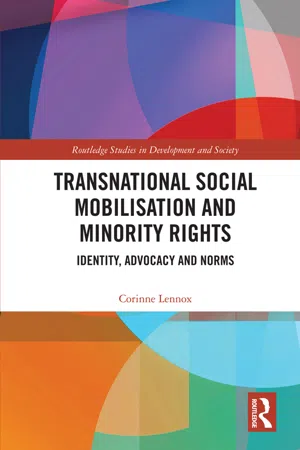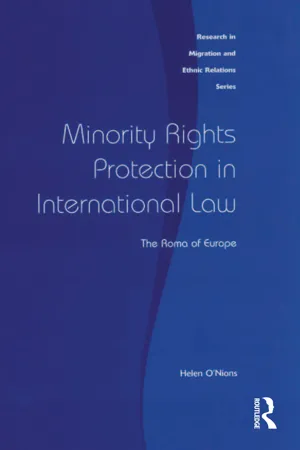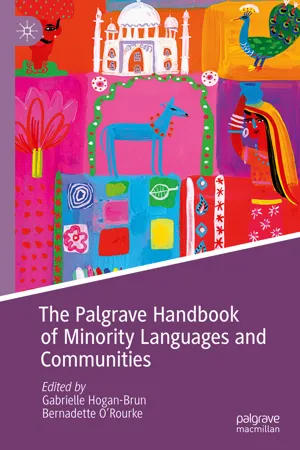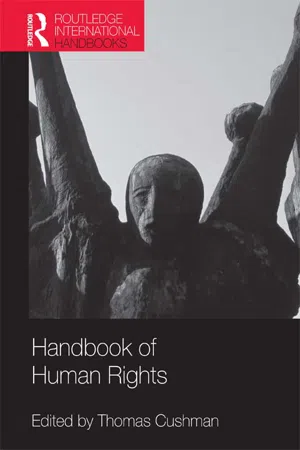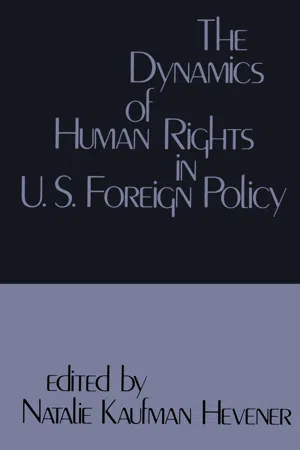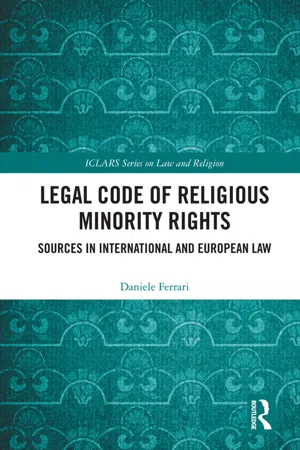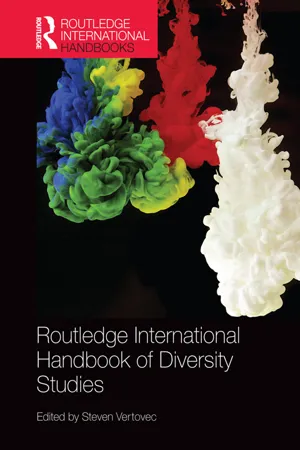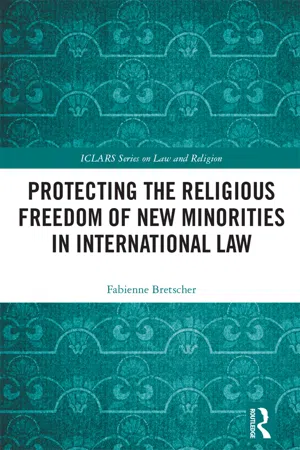Politics & International Relations
Minority Rights
Minority rights refer to the protection and promotion of the rights of individuals or groups who are in a numerical minority within a society. These rights aim to ensure equal treatment, non-discrimination, and the ability to participate fully in political, social, and cultural life. They often encompass issues such as language rights, religious freedom, and representation in decision-making processes.
Written by Perlego with AI-assistance
Related key terms
9 Key excerpts on "Minority Rights"
- eBook - ePub
Transnational Social Mobilisation and Minority Rights
Identity, Advocacy and Norms
- Corinne Lennox(Author)
- 2019(Publication Date)
- Routledge(Publisher)
The standards and mechanisms that constitute the international protection system for minorities provide an important normative framework to guide the relationship between minorities and states. Groups have framed their identities as ‘minorities’ and have participated in international society to use international institutions in order to bolster their weak influence at the national level. Global governance spaces provide opportunities for dialogue that often do not exist domestically because of the exclusion from political and economic power experienced by minorities. Norms can provide leverage in a domestic system that is structurally unfavourable and often oppressive to minorities. Minorities can use international law as a universal standard baseline for state practice in order to highlight gaps in adherence and push for change. States, however, have been self-interested in elaborating this protection system; consequently, the principal instruments are few in number, narrow in scope and weak in force. The potential for emancipation through international norms is severely limited by the content of the standards that reinforce state hegemony and the power of dominant groups.Minority groups and their rights represent a threat to states because they impact on order in international society, both in terms of stability and in terms of structure. Territorially concentrated minority groups potentially can undermine state sovereignty, particularly where such minorities question the legitimacy and identity of the state. Some minority groups constitute forms of political organisation and authority that are not statist in nature, such as transnational faith-based groups, which can compete with the supremacy of state power. Minority groups can also threaten the material power of states with claims to redistribution of resources or reparations for past injustices. These dynamics explain in part the construction of the international Minority Rights protection system and its restrictions.The only legally binding provision specifically for minorities at the international level is contained in Article 27 of the International Covenant on Civil and Political Rights (ICCPR) (1966), a standard which was replicated in Article 30 of the UN Convention on the Rights of the Child (1989) (CRC). Given the wide ratification of these two treaties, every state in the world is subject to a legally binding provision on Minority Rights. - eBook - ePub
Minority Rights Protection in International Law
The Roma of Europe
- Helen O'Nions(Author)
- 2016(Publication Date)
- Routledge(Publisher)
Chapter 6The Protection of Minorities in International Human Rights Law
Introduction
The importance of international human rights law in the protection of the rights of minorities has not been universally accepted.1 As a result, such protection has, in the past, been patchy and inadequate. Recent history has shown the world that Minority Rights cannot be ignored and that rather than increasing irredentist tendencies they may be a prerequisite for the peaceful stable societies which benefit us all.In a detailed study on the rights of minorities, Special Rapporteur Eide identified three crucial components in the protection of minorities: respect for the equality of all human beings; group diversity when required to ensure the dignity and identity of all; and an approach which aimed to advance stability and peace, both domestically and internationally.2 The first of these complimentary3 issues has been dealt with in Chapter 3 which raised serious questions over the ability of international law to protect minorities when grounded in a purely individualist foundation.This chapter will focus on the promotion of group diversity under international law. It will aim to clarify the types of groups protected and the extent of that protection while critically evaluating its effectiveness with reference to Eide’s third point.Minority Rights and non-discrimination can be viewed as two sides of the same coin. The United Nations Sub-Commission on the Prevention of Discrimination and the Protection of Minorities distinguished them as follows:1. Prevention of discrimination is the prevention of any action which denies to individuals or groups of people equality of treatment which they may wish.2. Protection of minorities is the protection of non-dominant groups which, while wishing in general for equality of treatment with the majority, wish for a measure of differential treatment in order to preserve basic characteristics which they possess and which distinguish them from the majority of the population.4 - eBook - ePub
Minorities' Claims: From Autonomy to Secession
International Law and State Practice
- Gnanapala Welhengama(Author)
- 2017(Publication Date)
- Routledge(Publisher)
Uncertainty about the precise definition has created confusion and ambiguity, and the concept of minority has become a controversial subject amongst international jurists and States. Without knowing who minorities are it is difficult to accommodate specific rights (Packer, 1993:26) because Minority Rights are different from general human rights. Consequently the rights and claims of minorities may be obstructed when they try to assert legal claims based on group identity before international tribunals. It is not necessary to emphasise that the identity of a person with a group is associated with his or her rights. How international law has so far failed to identify and define a minority in specific legal terms and why States have been reluctant to do so is the focus of this chapter. NonP recognition of Minority Rights has also been instrumental in the escalation of tension between minorities and States. 2.1 The Dilemma of Defining ‘a Minority’: “Controversial and, as yet, Unfruitful” States generally seem to be reluctant to agree a precise definition of minorities. Special Rapporteur Capotorti reported (1979: 95): When it comes to determining what groups constitute minorities, all kinds of difficulties arise. We have seen that, religious minorities apart, relatively few States expressly recognize the existence in their populations of groups described as ‘ethnic or linguistic minorities’ and that, while a considerable number of States have introduced measures granting special rights to various ethnic and linguistic groups, the majority prefer not to apply the term ‘minority’ to them. Eddison (1993:3) referred to the difficulties which States face in the search for an internationally acceptable definition of minority, as “a fundamental paradox of human rights discourses”, “definitional vacuum”, and “conceptual imprecision”. She says that such attempts “have been notably controversial and, as yet, unfruitful” (Eddison, 1993:3) - Gabrielle Hogan-Brun, Bernadette O'Rourke, Gabrielle Hogan-Brun, Bernadette O'Rourke(Authors)
- 2018(Publication Date)
- Palgrave Macmillan(Publisher)
36In Search of Meaning: Defining a Minority
Minority: The smaller number or part, especially a number or part representing less than half of the whole. […] A small group of people within a community or country, differing from the main population in race , religion, language, or political persuasion. (Oxford Dictionary )In addition to a continuing unease that still seems to persist around the nature and extent of Minority Rights and their relationship within the human rights paradigm, another controversial issue remains the very meaning of the term “minority” in international law, and therefore the identity of those who can claim, inter alia, the right to use their own languages with other members of their group. In his Study on the Rights of Persons Belonging to Ethnic, Religious and Linguistic Minorities ,37 Francesco Capotorti , Special Rapporteur for the Sub-Commission on Prevention of Discrimination and Protection of Minorities, first suggested his definition of what is a minority in the absence of any agreed upon understanding among member states of the UN, despite the adoption of Article 27 of the International Covenant on Civil and Political Rights a decade earlier which referred to linguistic, religious, and ethnic minorities . His report describes in great detail the inability among UN member states to reach any consensus on a definition, with frequent diverging and at times contradictory positions being discussed and the similar debates emanating when considering the absence of any agreed upon definition of a national minority in the contexts of European documents. As a consequence, he suggested a minority, for the purposes of Article 27 of the International Covenant on Civil and Political Rights , should be understood to mean a “group numerically inferior to the rest of the population of a State, in a non-dominant position, whose members – being nationals of the State – possess ethnic, religious or linguistic characteristics differing from those of the rest of the population and show, if only implicitly, a sense of solidarity, directed towards preserving their culture , traditions, religion or language”.38 It is this definition which is the most often circulated and referred to, including in more recent UN documents.39- eBook - ePub
- Thomas Cushman(Author)
- 2012(Publication Date)
- Routledge(Publisher)
sic ], colour, sex, religion, political or other opinion, national or social origin, property, birth or other status.” Consequently, minorities, as such, do not enjoy rights in the Declaration. Various attempts at including a recognition of minorities in the text were strongly opposed at the draft stages, the consensus being that “the best solution of the problems of minorities was to encourage respect for human rights” (see Thornberry 1991b, pp. 11–12). This was, in turn, the result of an emerging widespread conviction at that time that minority group rights were somehow incompatible with national and international peace and stability. As Claude has observed of these developments:The leading assumption has been that members of national minorities do not need, are not entitled to, or cannot be granted rights of special character. The doctrine of human rights has been put forward as a substitute for the concept of Minority Rights, with the strong implication that minorities whose members enjoy individual equality of treatment cannot legitimately demand facilities for the maintenance of their ethnic particularism.(Claude 1955, p. 211)Language rights are especially prone here to ongoing associations with the (unnecessary) promotion of ethnic particularism at the perceived expense of wider social and political cohesion. As the prominent sociolinguist Joshua Fishman ably summarizes this view:Unlike “human rights” which strike Western and Westernized intellectuals as fostering wider participation in general societal benefits and interactions, “language rights” still are widely interpreted as “regressive” since they would, most probably, prolong the existence of ethnolinguistic differences. The value of such differences and the right to value such differences have not yet generally been recognized by the modern Western sense of justice. - Natalie Kaufman Henever(Author)
- 2018(Publication Date)
- Routledge(Publisher)
The problem of protecting minorities is an old one. This chapter explores it from a contemporary perspective, seeking to define the issues which now crowd in upon statesmen everywhere — American statesmen not least among them. We begin by identifying some of the basic issues and more prominent milestones in the development of international protection of minorities under both the systems of the League of Nations and the United Nations. The highly influential historical role of United States policy in regard to minority protection is reviewed. This we follow with an examination of the case for and the case against international protection of minorities, in which we take cognizance of the urgent need for, as well as enormous hazards inherent in, a universalist approach to minority protection. We then consider several existing and less comprehensive approaches to minority protection (kin-state, transnational, and self protection), measuring their adequacy as alternatives to international protection. The discussion concludes with an assessment of options available to American policymakers in regard to international protection.The Development of International Protection
Viewing Minority Rights from a global historical perspective, one cannot fail to be impressed by the amount of human energy that has been expended in the long effort to obtain international guarantees for their protection.2 What began many centuries ago as occasional agreements among ruling princes extending protection to dissident and persecuted coreligionists in neighboring kingdoms has swelled since the turn of the twentieth century into a voluminous outpouring of resolutions, declarations, treaties, and covenants, many of them endorsed by virtually the entire international community, honoring the rights not only of religious but of linguistic, national, and racial minorities as well. Spurred on by the mammoth catastrophes inflicted on minorities in two world wars, the dissolution of polyglot empires, and the arousal of explosive political self-consciousness among minorities everywhere, contemporary statesmen have repeatedly avowed their belief in the interconnectedness of pacific international relations and the just treatment of minorities. Acutely aware of the frailty of good intentions, they have attempted to armor the conviction with the collective moral and political authority of international organization and law. While there is thus little doubt that violations of Minority Rights have been given more international attention in this century than ever before, the existence of an unequivocal and categorical international obligation to extend protection to minorities cannot yet be claimed. In fact, there has never been much unanimity among states as to which Minority Rights deserved protection, much less how, or even whether, rights were to be enforced. Indeed, precisely what constitutes a bona fide “minority” has not yet been internationally agreed.3- eBook - ePub
Legal Code of Religious Minority Rights
Sources in International and European Law
- Daniele Ferrari(Author)
- 2021(Publication Date)
- Routledge(Publisher)
Both indigenous peoples and minorities commonly wish to retain and promote their identity. Situations can be found on the ground where an indigenous group could find itself in a minority-like situation and, equally, some minorities have strong and long-standing attachments to their lands and territories as do indigenous peoples. Minorities, however, do not necessarily have the long ancestral, traditional and spiritual attachment and connections to their lands and territories that are usually associated with self-identification as indigenous peoples.In terms of rights, minorities have traditionally highlighted their rights to have their existence as a group protected, their identity recognized and their effective participation in public life and respect for their cultural, religious and linguistic pluralism safeguarded. Indigenous peoples, while also highlighting such rights, have also traditionally advocated recognition of their rights over land and resources, self-determination and being part of decision-making in matters that affect them. The United Nations Declaration on the Rights of Indigenous Peoples requires States to consult and cooperate with indigenous peoples to obtain their free, prior and informed consent before undertaking development activities that might have an impact on them, whereas the United Nations Minorities Declaration contains a more general right to participate in decision-making and requires that the legitimate interests of persons belonging to minorities should be taken into account in national planning and programming.This publication does not address the specificities of indigenous peoples, as its main focus is on non-indigenous national, ethnic, linguistic and religious minorities.c do Minority Rights apply to non-citizens?
Under the provisions of human rights instruments, States have an obligation to protect the rights of all persons subject to or under their jurisdictions. Express exceptions to this principle relate, inter alia, to political rights. - Steven Vertovec(Author)
- 2014(Publication Date)
- Routledge(Publisher)
Jackson-Preece 2012 : 528). The discussion of the right to identity follows the fundamental rights perspectives of the three dimensions of population diversity usually distinguished, namely cultural diversity, linguistic diversity and religious diversity.First, the scene is set with a section on the concept of minority, as well as typical characteristics and categories of fundamental rights.Setting the scene: minorities, migrants, state integration concerns and (the interpretation of) ‘fundamental rights'
Minorities make for an obvious angle of analysis in a handbook on diversity studies, as one of the essential characteristics of a minority is its separate ethnic, religious or linguistic identity. The lack of a generally agreed upon definition of the concept ‘minority’ goes hand in hand with a broad understanding of a range of essential characteristics, including a separate identity, numerical minority position, non-dominance and wish to hold on to the separate identity. It is exactly the ensuing vulnerable position of minorities which explains why the right to equal treatment in both its dimensions and the right to a separate minority identity are the overriding concerns of minorities and the foundational principles of minority protection.Traditional discussions of the concept of minority included a nationality requirement and/or the requirement of long lasting ties with the state concerned. Considering the extensive similarities in terms of reality, needs and concerns, it is increasingly accepted that migrant groups can qualify as (new) minorities and thus are entitled to Minority Rights. At the same time, arguments are put forward that migrant groups have less strong (minority) rights compared to traditional minorities, since duration of residence and traditional ties are among the relevant parameters for the sliding scale which is inherent in the formulation of these rights (Medda-Windischer 2009- Fabienne Bretscher(Author)
- 2019(Publication Date)
- Routledge(Publisher)
6767 HRC, GC 23 para 5.2 (emphasis added).Some scholars have criticised the HRC’s extensive definition of the concept of ‘minority’, in particular since it is seen as contradicting prior UN documents on the issue68 and jeopardising Article 27 ICCPR’s ‘credibility as the expression of an international minimum standard’.6968 See in particular UN Secretary-General, Annotations on the Text of the Draft of the International Covenants on Human Rights (UN Doc A/2929, 1955) para 184, which specifies that the term ‘minorities’ should cover only groups that are ‘well-defined and long-established on the territory of a State’.69 Gaetano Pentassuglia, Defining “Minority” in International Law: A Critical Appraisal (Lapland’s UP 2000) 30. See also Hannum 60f.The ECtHR did not develop a definition of the concept of ‘national minority’. When confronted with the issue, the ECtHR stated that the definition of the term minority, ‘by the nature of things, (must) be left largely to the State concerned, as it will depend on particular national circumstances’.70 Yet, it has been argued that ‘nothing stands in the way of an extensive interpretation of the concept of national minority’ under the ECHR, which excludes restrictive amendments such as citizenship.71 Indeed it seems that, although not explicitly stating so, the ECtHR uses the term ‘minority’ in a rather inclusive manner.72
Learn about this page
Index pages curate the most relevant extracts from our library of academic textbooks. They’ve been created using an in-house natural language model (NLM), each adding context and meaning to key research topics.
